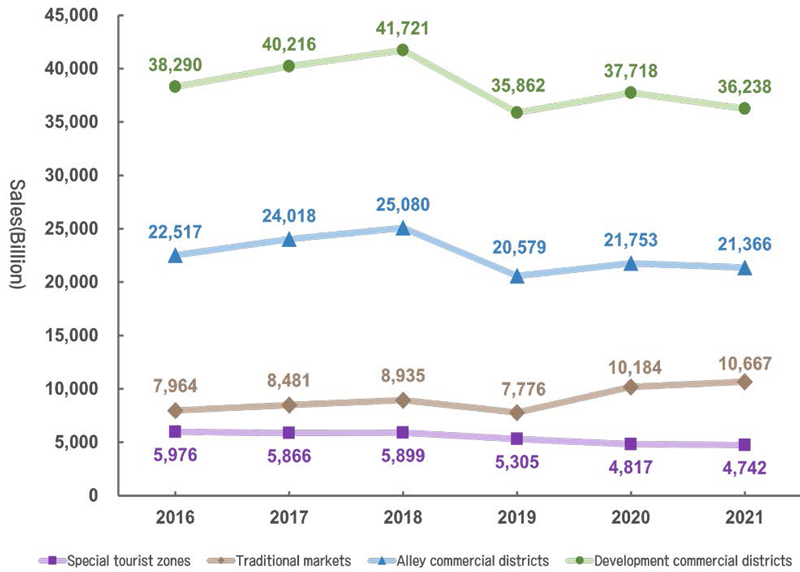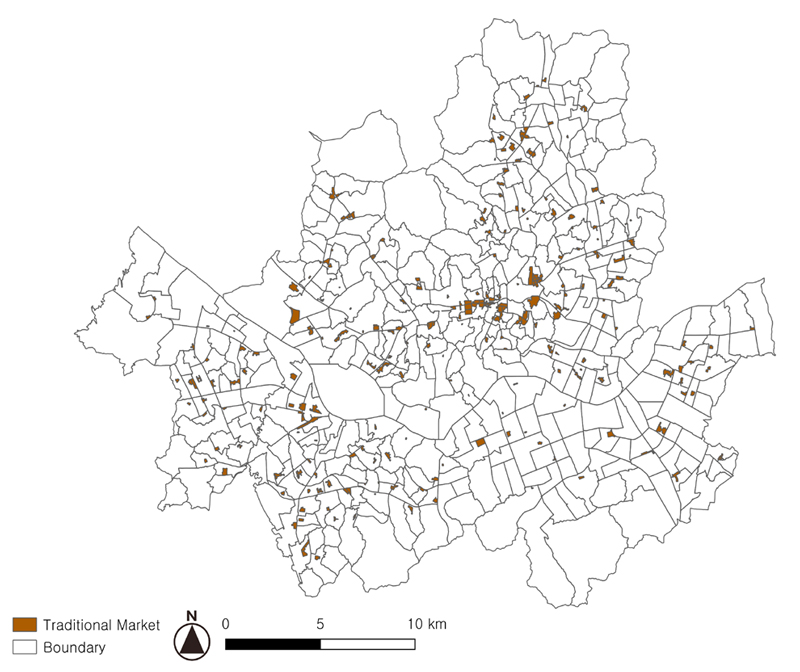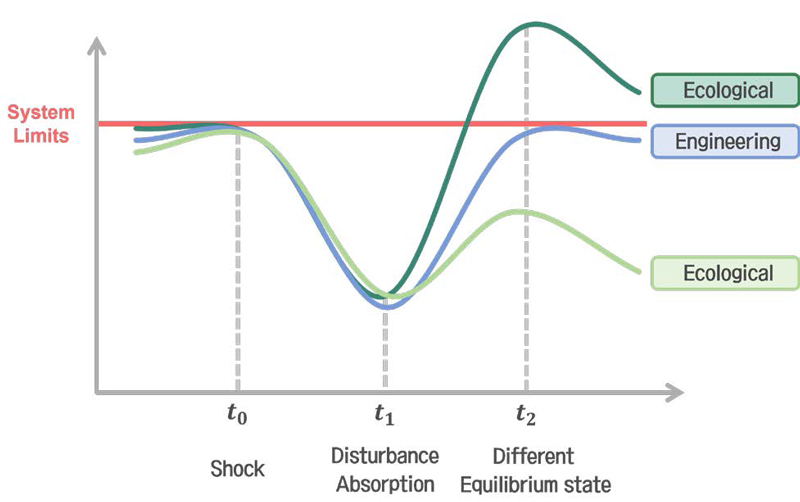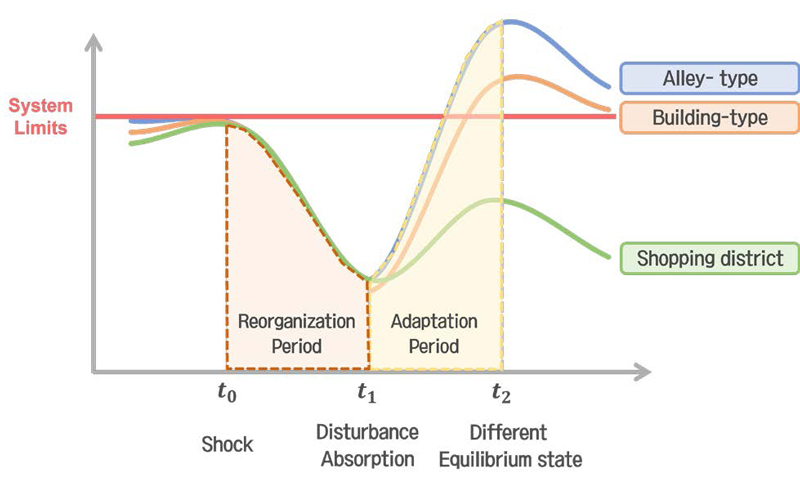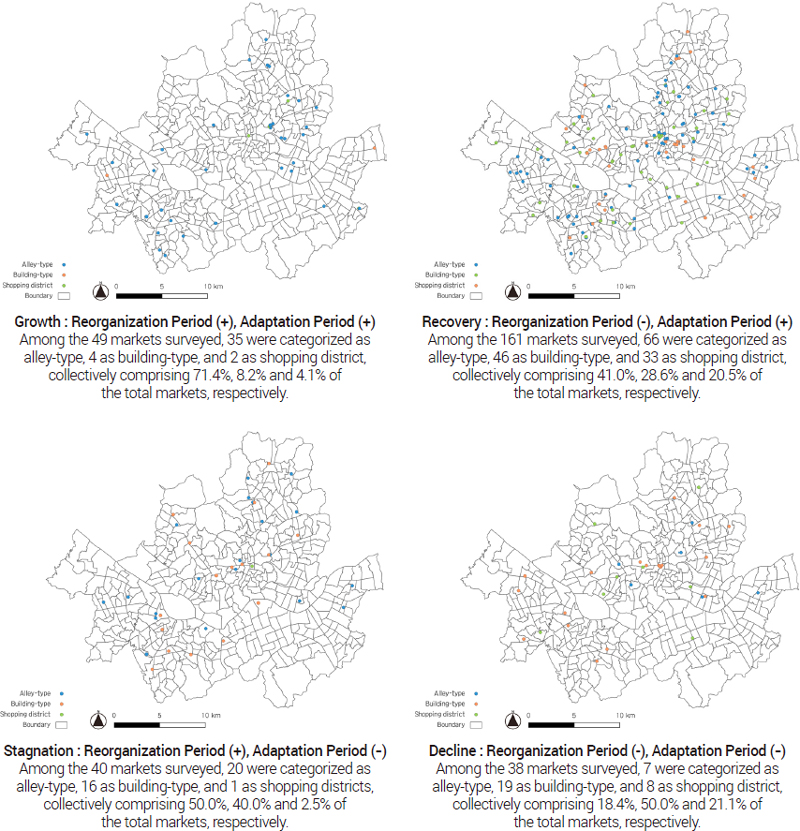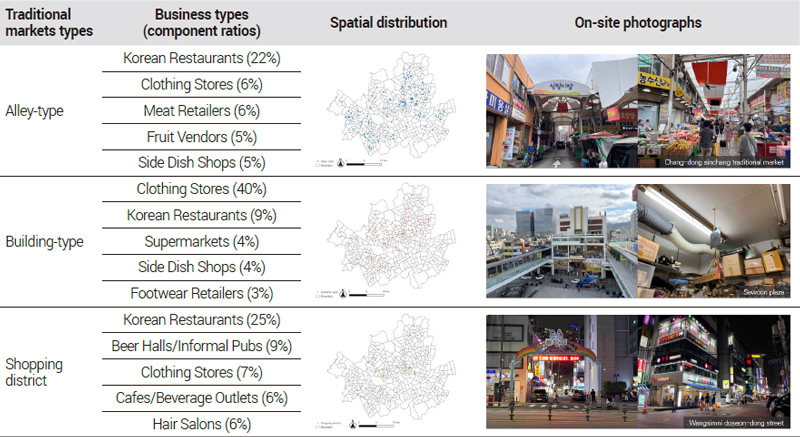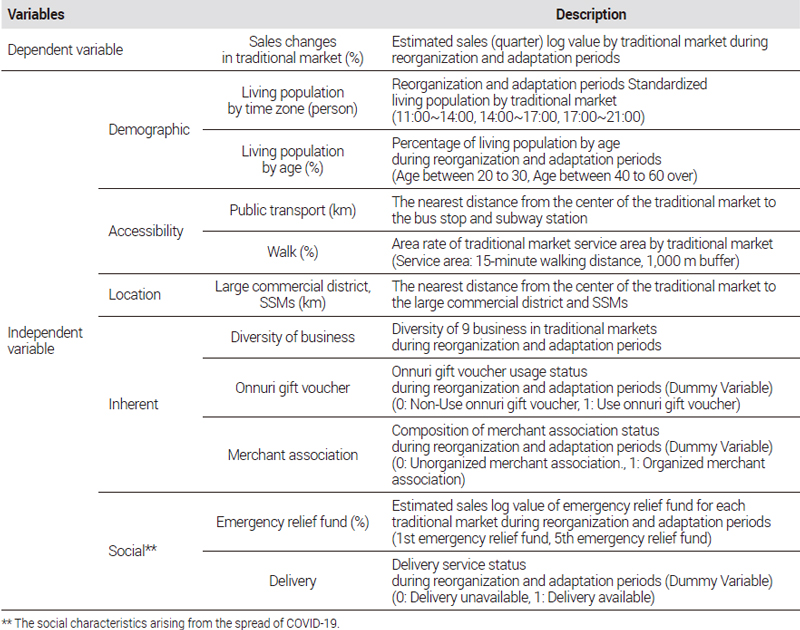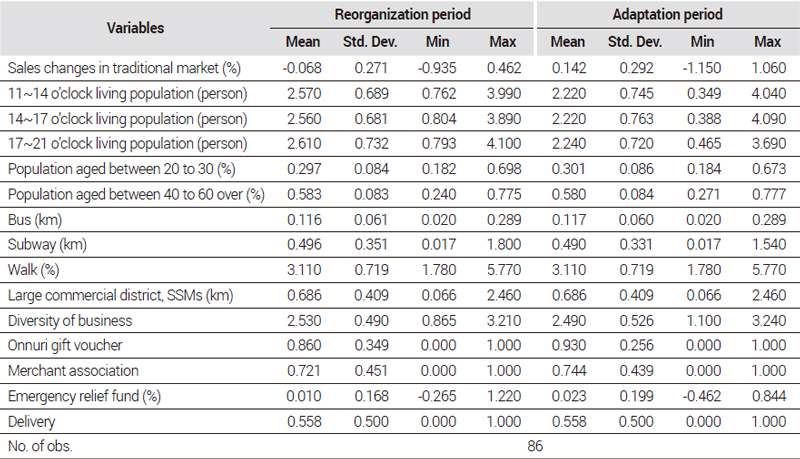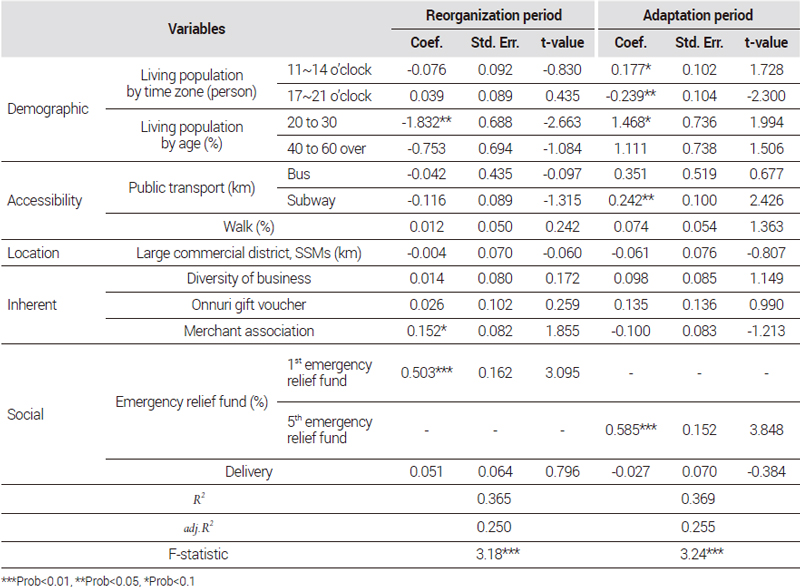
Final publication date 10 Nov 2023
COVID-19 Pandemic and Sales Resilience Factors : Focus on Alley-type Traditional Markets in Seoul, South Korea
Abstract
The spread of COVID-19 triggered lockdowns and inter-city travel restrictions, bringing daily life to a halt and posing substantial challenges to regional economies and commercial districts. However, traditional markets exhibited an unprecedented rise in sales during the COVID-19 situation, setting them apart from other commercial districts.
Therefore, this study metaphorically compares the sales resilience of traditional markets to complex systems, even in the face of the COVID-19 situation. It aims to extract factors contributing to sales resilience in traditional markets by comparing both before and after the COVID-19 periods. It explored the social circumstances and policy responses brought by COVID-19, along with shifts in sales trends and spatial distribution corresponding to the types of traditional markets, through current situation. In addition, it identified the elements contributing to the notable sales resilience observed in alley-type traditional markets.
The analysis revealed, firstly, that the business types and spatial distribution in traditional markets varied significantly based on their types. Secondly, during the reorganization period (Q4 of 2019 to Q1 of 2021) and adaptation period (Q1 of 2021 to Q4 of 2022), sales changes across various traditional markets types were categorized into four distinct patterns: growth, recovery, stagnation, and decline, indicating divergent impacts of COVID-19. Thirdly, the key factors behind the heightened sales resilience in alley-type traditional markets during the COVID-19 period were identified as demographic, inherent, and social features influenced by COVID-19.
The results of this study interpret the phenomena indicated by the individual components constituting the ‘traditional market’ systems, adapting and evolving in response to the impacts of ‘COVID-19’. This signifies that the historical significance, community connectivity, and proactive response capability inherent in traditional markets have been important in influencing sales resilience both before and after the COVID-19 periods. Finally, the study holds significance in providing empirical analysis of the sales resilience and its factors in traditional markets from a long-term viewpoint, utilizing the lens of complexity theory.
Keywords:
Traditional Market, Sustainability, COVID-19, Complexity Theory, ResilienceⅠ. Introduction
Over the years, traditional markets in urban areas have steadfastly served as socio-economic and cultural hubs, adapting to changes in demand and supply and being perceived as flexible and dynamic venues. Evolving in sync with the local history, these markets have positioned themselves as integral elements of local cultural heritage, offering spaces where a myriad of economic entities within the region can interact mutually (Pottie-Sherman, 2011; Prastyawan et al., 2015).
The significance and merit included in traditional markets are prominently manifested in both economic and non-eco nomic dimensions. Situated at the heart of various regions, these markets not only foster numerous direct and indirect employment opportunities but also act as pillars sustaining the local economy. In addition, they cultivate environments that foster social interactions, facilitating the formation of cohesive local communities (Pottie-Sherman, 2011; Angmor, 2012).
Despite the broad acknowledgment of their critical role and necessity from several angles, traditional markets face a gradual decline. This downturn is spurred by evolving consumer preferences and trends, among other factors (Yeo, 2014). Furthermore, there is a glaring gap in substantial discussions and initiatives aimed at the sustainability and revitalization of these markets (Shin et al., 2015).
The urgency for the sustainability and recovery of traditional markets has been underscored further in the wake of the COVID-19 pandemic. This global crisis instigated socio-economic upheavals and unprecedented changes in daily life routines (WHO, 2020). To curb the virus's spread, social distancing measures were enacted, resulting in diminished face-to-face interactions and predicting new lifestyle adaptations (Korea Disease Control and Prevention Agency, 2021; Lee, 2021). Notably, the apprehension and fear generated by the risk of COVID-19 infection, coupled with the enforcement of social distancing policies, induced a shift towards community-centered activities, affecting the sales of several commercial districts, including traditional markets.
According to a report by the Seoul Metropolitan Council (2022), commercial districts in Seoul exhibited a sharp decline in sales starting in 2019, following a peak period in 2018, a downturn aggravated by the emergence of COVID-19 (see <Figure 1> for reference).
Areas such as special tourist zones1), alley commercial districts2), development commercial districts3) with high population density and a significant presence of entertainment industries, where the allocation of emergency relief funds was restricted, faced stringent operational constraints in terms of business hours and staff numbers, consequently failing to recover their total sales even after the onset of COVID-19 (Kwon and Jeon, 2022).
Conversely, traditional markets, comprising industries closely intertwined with local lifestyles and unrestricted in utilizing emergency relief funds, evidenced a perceptible uptrend in overall sales following the COVID-19 outbreak, a growth continued through 2021 (Hong, 2020; Ryu and Kim, 2021).
An evaluation was undertaken to discover the differences in resilience and the extent of COVID-19’s impact, monitoring the variations in sales across different commercial districts in Seoul both before and after the onset of COVID-19. This analysis indicates that the distinct characteristics constituting the commercial districts in Seoul have demonstrated varied responses to the altered conditions brought about by COVID-19, aligning with the policy restrictions enacted during the pandemic. The assessment emphasizes a critical period where a thorough examination of the traditional markets, which have experienced an unprecedented surge in sales compared to other commercial districts, becomes imperative.
Therefore, the purpose of this study is to emphasize the sales resilience displayed by traditional markets in the COVID-19 environment and to explain their sales resilience from the perspective of complexity theory. This study illuminates the changes in traditional market sales that have emerged in the new context of ‘COVID-19’ and identifies the factors that have contributed to their resilience through empirical analysis. Additionally, its aim is to analyze the influence of COVID-19 on different types of traditional markets. This study provides insights into the sustainability and future directions of traditional markets, offering implications for supporting and managing policies in the event of future external shocks.
Following the spread of COVID-19, 288 traditional markets in Seoul exhibiting sales resilience were selected as the geographical scope of the study. However, 38 traditional markets were excluded due to a lack of data or because they were undergoing redevelopment or reconstruction, thereby losing their original function (see <Figure 2> for reference). As a result, the time frame for this study extends from the fourth quarter of 2019, before the onset of COVID-19, to the fourth quarter of 2022, a period marked by a gradual resumption of normal activities as the impacts of COVID-19 began to relieve.
The methodological framework is structured as follows: In order to identify the factors contributing to the sales resilience of traditional markets, a detailed analysis of the concepts and attributes of traditional markets was initiated, coupled with an exploration of the transformations brought about by COVID-19 in these markets. In addition, a thorough review of previous research focusing on complexity theory and resilience was conducted. This was followed by an analysis of the current status of traditional markets in the wake of COVID-19, identifying the changes in sales according to the various types of traditional markets. Finally, through a comprehensive review of preceding studies, variables that are integral to the analysis of factors influencing sales resilience in traditional markets were selected, utilizing multiple regression analysis to pinpoint the central factors aiding sales resilience in alley-type traditional markets.
Ⅱ. Literature Review
This research began with an analysis aiming to identify the factors encouraging sales resilience of traditional markets post the COVID-19 outbreak. It involves a detailed inspection of the fundamental and social traits exhibited by traditional markets affected by COVID-19, alongside a consideration of their foundational concepts and essential characteristics. Furthermore, an effort was made to operationally define the concept of resilience pertinent to traditional markets, facilitated through an extensive review of studies that explore complexity theory and the principles of resilience.
1. Understanding Traditional Markets
As outlined in the “Special Act on the Development of Traditional Markets and Shopping Districts”, traditional markets are defined as ‘locations that have either developed naturally or been established in response to social and economic necessities, where transactions of goods or services primarily occur through traditional methods grounded in mutual trust’. These markets, where space and time coexist seamlessly, are open to everyone and recognized as hubs fostering interactions between people and goods (Jeong, 2006). Traditional markets, exceeding their function as mere venues for buying and selling goods, have historically played a critical role in building local communities, serving as significant public spheres since the Joseon era. Not only have they been centers for gatherings and religious events, but they have also facilitated interactions and exchanges among community members, thereby playing a critical role within local societies (Jeong, 2006; González and Waley, 2013). The relational interactions nurtured within these markets have served as a foundation for cultivating regional culture and identity, where various individuals meet, share aspects of their lives, and nurture a deep sense of community, thereby sustaining the essence and value of these markets through heartfelt connections formed therein.
Initially, traditional markets were segregated into building-type and street-type categories, classifications that were based on the nature of businesses and the arrangement of spatial distribution. In building-type markets, specific territories are distinctly demarcated based on their respective plots. These markets predominantly deal in consumer goods such as clothing, furniture, and cosmetics, which generally involve less interaction with customers. These markets feature a grid-like internal layout and compartmentalized stores (Kang and Yim, 1999).
On the other hand, street-type markets have a close association with the surrounding hinterlands, primarily hosting food and beverage businesses. These markets exhibit a remarkable attribute of undergoing spatial and usage transformations, adapting to different times of the day and seasons. Despite occupying the same space, these markets showcase inherent naturalness and flexibility, adjusting according to prevailing circumstances. During the day, they specialize in offering agricultural produce and essentials, transitioning into hubs for food and alcoholic beverages in the evening. Moreover, these markets adapt to seasonal changes, manifesting an open format during the summer and a more closed structure in winter, epitomizing the ever-adaptive nature of traditional markets (Kang and Yim, 1999).
As time progressed, the types of traditional markets diversified, evolving into various categories such as alley-type, building-type, shopping district, underground shopping center, and mixed type. Among these, the alley-type (early street-type), building-type, and shopping districts are seen as the most representative forms. Moreover, it was observed that the business types and spatial distribution vary considerably based on the types of the traditional market in question (see <Table 1> for reference).
The alley-type traditional markets predominantly focus on the sale of fresh goods including meat, fruits, and side dishes, closely connected with the daily life of the local populace, and are mainly concentrated in northeastern and southwestern regions such as Yangcheon-gu and Gangbuk-gu. Conversely, building-type traditional markets, specializing in retailing consumer and processed goods like clothing, supermarkets, and footwear, are chiefly located in urban districts like Jung-gu and Yongsan-gu. Meanwhile, the shopping district traditional markets, focusing on leisure activities, house establishments like pubs, cafes, and beauty salons, and are prominently situated in areas such as Seodaemun-gu and Gangnam-gu, becoming the recreational focal points in the northwestern and southeastern regions.
2. Factors Influencing Sales Resilience in Traditional Markets
Ongoing research seeks to identify the factors influencing the sales trends in traditional markets, thereby aiding in the establishment of strategic developments and policy directions. These empirical studies consider a variety of aspects including physical surroundings, inherent attributes, demographic particulars, accessibility, locational features, and regional characteristics.
In response to the changing retail market dynamics, a campaign initiated in 2004 aimed at revitalizing traditional markets through the improvement of their physical environments (Kim, 2004). This period also necessitated the enhancement of merchant capabilities and the formation of merchant associations. The evolution of individual merchant abilities transitioned into alterations in social and political capacities, with the legal organizational structure proving to be effective (Song and Beom, 2011; Heo and Lee, 2012).
Moreover, the introduction of the “onnuri gift voucher” - aimed at bolstering the economic growth and supporting the merchant community within traditional markets - has had a positive impact on increasing the user base of these markets, consequently contributing to economic activation and stabilization in the traditional markets (Lim and Yoon, 2015; Lee et al., 2018).
A comprehensive analysis conducted by Lee et al. (2021) investigated the multifaceted transformations in traditional markets. This study utilized logistic regression analysis with demographic and regional factors as variables, revealing that the concentration of population active during the prime usage hours, along with the proximity to subway stations, positively influences the increase in storefront numbers within traditional markets. However, the emergence of large commercial districts and SSMs appeared to have a negative effect on storefront expansion. A considerable body of research examining the relationship between the advent of large commercial districts, the entry of SSMs, and traditional market sales, portrays a negative perspective regarding the sales growth in traditional markets following these new entries (Ahn et al., 2013; Lee et al., 2015). Conversely, Lee (2019) highlighted a synergistic effect amplified by the influx of customers to local markets following the establishment of large commercial areas and SSMs.
Traditional markets maintain a distinctive allure with their diverse business compositions and complementary product assortments (Kim, 2004). Particularly, an increased presence of fresh food outlets and restaurants correlates with a rise in store sales and customer satisfaction, as well as a reduction in vacancy rates. This suggests that business diversity plays a critical role in encouraging continuous visits to traditional markets (Shim, 2013; Yi and Kim, 2018).
In the wake of COVID-19, distinct social trends have surfaced, illustrating the profound impact of the pandemic on the initiation and cessation of eateries. This phenomenon has been significantly influenced by alterations in population demographics and time-segmented activity patterns in the post-COVID-19 period, underlining the transformative effects instigated by the pandemic (Ji, 2021). Concerning public transportation such as buses and subways, a notable susceptibility to the results of COVID-19 has been evident, especially when juxtaposed with personal vehicles and public bicycles. This can be attributed to variations in infection risks, culminating in a marked decline in the utilization of public transportation, spurred by increased infection fears (Kim et al., 2021).
The analysis In addition scrutinized the effects of the emergency relief funds on consumer expenditures during the COVID-19 period. These funds, allocated in five distinct period, were accepted in numerous local establishments, barring certain restricted entities like department stores and large supermarkets. The avenues of distribution included personal credit and debit cards, local love gift voucher, and prepaid card. The first was distributed universally to all citizens, while the fifth was allocated selectively based on specified criteria. In contrast, the second to fourth emergency relief funds were particularly targeted towards groups such as small business owners, beneficiaries of emergency employment stability programs, and individuals in lower-income brackets, facilitating direct financial assistance.
Examining the policy implications of the emergency relief funds, Hong (2020) identified the sector-specific discrepancies in consumer expenditures, emphasizing a significant increase in the supermarket and food sectors. Similarly, Kim and Oh (2020) identified a gradual resurgence in consumption levels that had been suppressed by COVID-19, observing a subsequent surge in sales figures, ranging between 26.2% and 36.1%, within eligible sectors following the distribution of the emergency relief funds.
Lastly, the pandemic has considerably expanded the scope of delivery services, catalyzing a vibrant trend of contactless consumption through applications (hereafter referred to as apps). Hong and Yang (2021) highlighted a positive correlation between the systematic characteristics of delivery service apps, delivery attributes, and promotional activities pertaining to product sales, with operational outcomes. They urged the strengthening of communication aspects between service providers and consumers by enhancing the functionality of delivery services. The increasing importance of delivery services in traditional markets has been amplified amidst the spread of COVID-19, marked by a growing preference for utilizing traditional markets remotely via a variety of online platforms and apps, including “Nolleowa-yo Market” (hereafter referred to as “WIJU Market”), Coupang Eats, and Naver Shopping Local Market Grocery Shopping.
3. Complexity Theory and Resilience
Modern urban environments continually undergo transformations, influenced by an array of circumstances and environmental factors. Cities that adapt to these evolving situations tend to flourish, while those that fail might experience decline or even obsolescence (Lim, 1999). This perspective is fundamentally grounded in complexity theory. Complexity systems are networks where numerous individual elements engage in multifaceted interactions. These elements display nonlinear dynamics, with the key characteristics of complexity systems being defined as emergent behavior, self-organization, and resilience (Cho and Ryu, 2013).
The term “emergent behavior” denotes the spontaneous manifestation of traits or actions within the overall structure that were not apparent in individual components, leading to unpredictable outcomes. “Self-organization” refers to the phenomenon where individual elements autonomously formulate structures, fostering new systems in the process. “Resilience” describes the ability to adapt and evolve in response to external changes, where minor alterations can exert significant impacts on various aspects of the system (Cho and Ryu, 2013; West, 2018).
Discussions on resilience initially found ground in the fields of mechanics and medicine, gradually extending into psychology and ecology. This concept was significantly expanded by ecologist Holling in 1973, catalyzing efforts to empirically measure resilience (Alexander, 2013). From an ecological standpoint, resilience is portrayed as an inherent characteristic of ecosystems. Following an external shock, an ecosystem seeks to absorb the changes and disruptions, aiming to return to an equilibrium state. However, if the disruption persists over a considerable period, the system reaches a threshold, transitioning to a different equilibrium state. This ecological attribute is denominated as “stability”, with the concept of resilience being identified through two aspects of stability (Holling, 1973; Holling, 1996) (see <Figure 3> for reference).
The first aspect of stability refers to a scenario where, following an external shock, alterations within the system are absorbed, allowing for a full restoration to the original equilibrium state; this is termed “Engineering Resilience”. Conversely, the second aspect of stability entails a scenario wherein, subsequent to an external shock, the transformations within the system transcend its original boundaries, evolving in such a manner that the previous equilibrium state either no longer persists or transitions to a different state. This phenomenon is referred to as “Ecological Resilience” (Holling, 1973).
Although the notion of resilience exhibits variations depending upon the field and scope, it is universally characterized as the ability to adapt in situations of stress, confusion, external shocks, and changing circumstances, and to return to either the original or a transformed state (Kang and Lee, 2017). In the domains of natural disasters and disaster management, resilience is defined as the ability to rehabilitate damaged systems, centrally focusing on the analysis of damage extent caused by the catastrophe (Vugrin et al., 2011). A prominent method entails quantifying resilience by evaluating the disaster resistance cost index (Yu et al., 2014).
Recently, the recognition of the significance of resilience in local areas has intensified, leading to rapid increase of studies examining resilience in urban spaces and commercial districts. Yun et al. (2021) interpreted resilience as the capability to minimize damage and recover rapidly in the face of external shocks, treating COVID-19 as a disaster and assessing resilience in different urban spaces using sales data.
Furthermore, Ha and Lee (2021), who analyzed factors affecting the decline in neighborhood commercial sales and the impact on resilience, adopted the resilience indicators developed by Han and Goetz (2015) to define resilience as the ratio of sales decline to recovery. Similarly, Lee et al. (2022) identified resilience as a rebound to levels or trends prior to the shock, evaluating the resilience of different types of alley commercial districts, and extracting factors affecting business crises in these areas through survival analysis.
Meanwhile, international cases that examined the resilience of traditional markets, such as earthquakes and the COVID-19 situation, were also reviewed. Hao et al. (2016) found that fresh food markets contribute to the development, cohesion, and resilience of local communities after natural disasters like earthquakes. Even in disaster situations, fresh food markets connect people and spaces by establishing social networks and strengthening bonds between merchants and customers over time. Similarly, Falknor (2022) viewed the recovery of social cohesion at Fulton Street Farmers Markets after COVID-19 as a tool for resilience and aimed to redefine the market's role.
Thus, the sales resilience of traditional markets was defined by drawing on previous domestic studies that operationally defined resilience and international research that considered post-COVID-19 social cohesion as an indicator of resilience in traditional markets. The resilience of traditional markets is perceived from the perspective of the “traditional market” system adapting to the changes brought about by “COVID-19”. This notion is not merely quantifiable through numerical data but is perceived as a reflection of the longstanding values and characteristics of the traditional market, accumulated over time and evident in its response to numerous crises and changes. Hence, this study defines the resilience of the traditional market as “the historical significance inherent in the traditional market, its symbiotic relationship with the local community, and its flexibility to proactively respond to various crises”.
4. Distinctiveness of the Research
Traditional markets serve as vital hubs in communities, standing as central venues where interpersonal interactions and the exchange of goods occur. Previous studies related to traditional markets aimed to identify future trajectories for these markets, by analyzing activation factors and sales influence factors based on their inherent characteristics. Despite more recent studies considering a variety of factors including demographic traits, location attributes, and regional features, the research in this domain has yet to advance significantly.
Following the sudden outbreak of COVID-19, there were considerable changes in daily life, with different commercial districts demonstrating varied degrees of impact and resilience to the results of the pandemic. Existing research on commercial resilience mainly focused on neighborhoods and alley commercial districts that experienced a decline in sales during the COVID-19 period, with an aim to explain the factors influencing resilience.
However, there has been a noticeable gap in research concerning the rapid sales growth and resilience of traditional markets in the post-COVID-19 environment. This emphasizes the necessity for the present study, which seeks to initiate discourse on spatial unit resilience at this time. Therefore, this study stands out by scrutinizing the sales resilience of traditional markets through the perspectives of complexity theory and resilience, offering an empirical analysis of the long-term effects of COVID-19 on traditional markets and the factors contributing to sales resilience.
Ⅲ. Analysis of the Research Area
1. Variations in COVID-19 Case Numbers and Sales Trends in Traditional Markets
As the COVID-19 pandemic unfolded, traditional markets witnessed a growth in sales, a trend presumably influenced by the social shifts triggered by COVID-19 and governmental preventive directives. To further examine the shifts in sales within traditional markets, a comparative analysis was undertaken, juxtaposing the quarterly figures of new infection rates on a national level and in Seoul against the sales trends in traditional markets, with policy responses also taken into account (see <Figure 4> for reference).
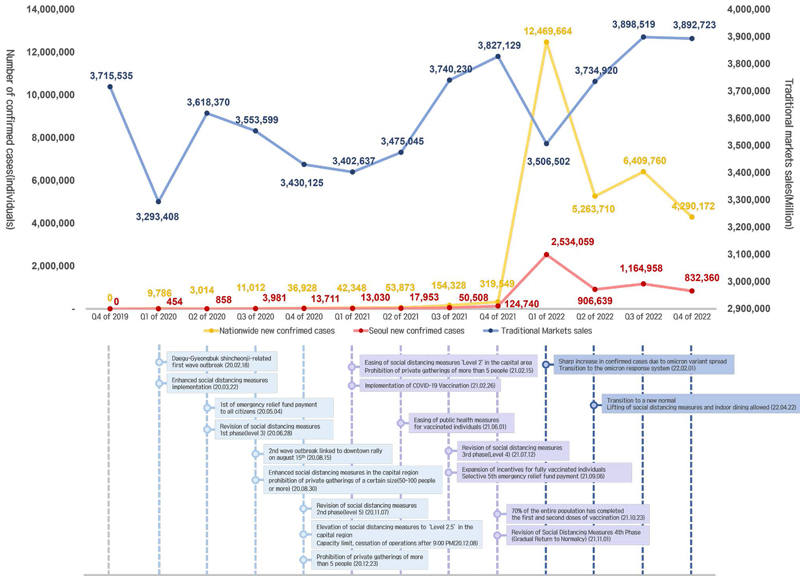
Comparison of Nationwide/Seoul new case numbers, policy responses, and traditional market sales trends
Following the emergence of COVID-19 in the first quarter of 2020, sales in traditional markets dropped sharply compared to the final quarter of 2019, reaching an unprecedented low. However, with the distribution of the first emergency relief funds to all citizens in the second quarter of 2020, a recovery in market sales was observed. Nevertheless, due to the persistent spread of COVID-19 and a gradual increase in new cases, operational hours and the number of patrons were restricted in the fourth quarter of 2020. In addition, owing to heightened social distancing measures, the first quarter of 2021 reported the lowest sales figures since the first quarter of 2020, excluding the initial outbreak period. Subsequently, the initiation of vaccination programs, the easing of preventive measures, and a gradual recovery of normalcy led to a continuous increase in traditional market sales up to the fourth quarter of 2021, surpassing the sales figures recorded in the fourth quarter of 2019, before the onset of COVID-19.
However, in the first quarter of 2022, a sudden surge in the number of cases due to the Omicron variant demonstrated a different trend compared to previous periods, leading to a decline in sales in traditional markets. Despite this, it indicated higher sales compared to the first quarter of 2021 when social distancing measures were most strict. Following the implementation of response systems to curb the Omicron spread, the rollout of the third round of vaccinations, and the lower fatality rate of the variant, a transition to a new form of normalcy was observed in the second quarter of 2022. With the lifting of social distancing measures, a revival in the sales of traditional markets was identified.
2. Changes in Sales Based on the Type of Traditional Markets
The traditional markets can be categorized into alley-type, building-type, shopping district, underground shopping center, and mixed-type. However, in Seoul, the number of underground shopping center and mixed-type traditional markets is not substantial; hence the focus was mainly on analyzing the sales changes in alley-type, building-type, and shopping district traditional markets (see <Figure 5> for reference).
Both alley-type and building-type markets witnessed an increase in sales from the spread of COVID-19 until 2022, with the alley-type markets, in particular, showing a drastic growth compared to 2019. This sales trajectory is presumed to be due to reduced mobility and localized activities brought on by the pandemic restrictions. Conversely, the shopping district traditional markets experienced a decline in sales from 2019 to 2021, with a recovery in 2022 following the relaxation of social distancing measures and transition into a new phase of normalcy. This rebound is interpreted as an outcome influenced by the business types and locations of the shopping district traditional markets, allowing the observation of diverse sales trajectories depending on the type of the traditional markets.
3. Spatial Distribution of Sales Changes According to the Types of Traditional Markets
The sales growth in traditional markets is perceived as the system’s adaptation to the shocks induced by COVID-19, where the components of the traditional market system underwent reorganization to maintain stability, adapting to a new altered state. Thus, the differing sales changes per market type can be seen as results of this reorganization and adaptation process, wherein the system absorbed the modifications induced by COVID-19.
To further inspect these sales changes in greater detail, quarterly sales data was utilized. The analysis framed these fluctuations within the concept of resilience, distinguishing between reorganization and adaptation periods and examining the corresponding spatial distribution.
The reorganization period spanned from the pre-COVID-19 (t0: Q4 of 2019)~COVID-19 to the point where the most strict COVID-19 restrictions were in place (t1: Q1 of 2021). The adaptation period, on the other hand, was identified from the period with the strictest restrictions (t1: Q1 of 2021)~COVID-19 to the transition into the post-pandemic new normal (t2: Q4 of 2022) (see <Figure 6> for reference).
An analytical examination was conducted to investigate the spatial distribution of sales changes across various types of traditional markets during the reorganization and adaptation periods. These markets were categorized into four distinct groups : growth, recovery, stagnation, and decline, according to the classifications proposed by Yoon and Lee (2009) (see <Figure 7> for reference).
The growth category encompasses traditional markets that have witnessed an increase in sales during both the reorganization and adaptation periods. These markets are mostly situated in northeastern and southwestern residential areas, with alley-type markets representing 71.4% of the total markets. Conversely, the recovery category includes markets that experienced a decrease in sales during the reorganization period but an increase during the adaptation period, indicating an upturn in sales following the easing of COVID-19 restrictions. The stagnation category, however, portrays markets that encountered an increase in sales during the reorganization period but a reduction during the adaptation period, showcasing a decline in sales after the easing of COVID-19 restrictions. The discrepancy between these two categories is reflected in the proportion of shopping district traditional markets, with recovery and stagnation documented at 20.5% and 2.5%, respectively. This discrepancy suggests that during the peak of COVID-19 restrictions, activities mainly occurred in community residential areas, overshadowing leisure venues like bars and cafes.
The decline category includes traditional markets where sales have diminished consistently throughout both the reorganization and adaptation periods, primarily found in urban centers and business districts. The building-type markets constitute 50.0% of the total markets space. Notably, this trend seems to contain the inherent characteristics of building-type markets, which generally comprise enclosed areas conducive to the prolonged presence of the COVID-19 virus.
In conclusion, this study explained the spatial distribution of sales changes in line with the types of traditional markets. For a deeper analysis, future studies intend to focus on alleytype markets, which demonstrated significant sales resilience during both the reorganization and adaptation periods, aiming to identify the factors contributing to this resilience.
Ⅳ. Analysis of the Resilience Factors in Alley-type Traditional Markets Sales
This study aimed to identify the critical factors affecting sales resilience in alley-type traditional markets, utilizing processed data obtained from platforms such as the Seoul Open Data Plaza, the National Spatial Data Infrastructure Portal, and the Public Data Portal. The spatial data manipulation was facilitated using QGIS 3.28.0, while multiple regression analysis was conducted with Jamovi 2.3.18.
The study segregated the evaluation into two periods: the reorganization period (Q4 of 2019 to Q1 of 2021) and the adaptation period (Q1 of 2021 to Q4 of 2022). An analysis was carried out on 86 alley-type traditional markets, excluding those surpassing 1.5 times the interquartile range (IQR) from a pool of 288 traditional markets.
1. Variable Configuration
The dependent variable was formulated by calculating the logarithm of the estimated quarterly sales for each traditional market during the reorganization (Q4 of 2019 to Q1 of 2021) and adaptation periods (Q1 of 2021 to Q4 of 2022), as depicted in formula (1) (Yoon and Lee, 2009).
| (1) |
The independent variables were identified based on theoretical discussions and a review of previous studies, categorized into demographic attributes, accessibility features, locational characteristics, inherent qualities, and social aspects (see <Table 2> for reference). To observe the changes precipitated by the COVID-19 pandemic, demographic attributes were analyzed using data on population characteristics segmented by time and age. The time-segmented population data were subdivided into six time intervals: 00:00~06:00, 06:00~11:00, 11:00~14:00, 14:00~17:00, 17:00~21:00, and 21:00~24:00. Utilizing formula (2), the population count during the high market visitation periods of 11:00~14:00, 14:00~17:00, and 17:00~21:00 was standardized, as documented in studies by Seoul Credit Guarantee Foundation (2021) and Jung and Nam (2019).
| (2) |
In addition, the age-segmented population data were considered, focusing on the primary age groups (20~30 years and 40~60 years and above) utilizing traditional markets (Park, 2013). The proportion of a certain age groups were calculated following formula (3), which refers to a study by Ha and Lee (2021).
| (3) |
The study identified accessibility characteristics based on the research conducted by Kim et al. (2021), which examined the changes in modes of transportation and mobility in response to the spread of COVID-19. In addition, this research utilized pedestrian accessibility, a primary method of visitation to traditional markets (Seoul Credit Guarantee Foundation, 2021).
Public transportation accessibility was quantified as the nearest distance from the central point of traditional markets to the closest bus stops and subway stations. Concurrently, pedestrian accessibility was defined as a service area that is accessible by walk within a 1,000 m buffer from the central point of the traditional markets, by considering approximately 15 minutes of walking time. This was calculated as the ratio of the pedestrian service area to the total area of the traditional markets. In addition, locational attributes were assessed by determining the shortest distance from the markets central point to large commercial districts and Super Supermarkets (SSMs).
The inherent attributes were identified by selecting variables capable of capturing the distinct features exclusively present in traditional markets compared to other commercial districts. To measure the diversity of business, a determinant of the competitiveness of traditional markets, the study utilized Shannon's diversity index (1949), as depicted in formula (4) (Chea and Shin, 2015). It is significant that this diversity index does not signify the qualitative aspect of a commercial district but serves to assess the degree of variety within business categories (Kim and An, 2019).
| (4) |
Business classifications were reorganized into nine categories, in accordance with the medium classification of the Korean Standard Industrial Classification (KSIC) and the closely-related businesses disclosed in the Seoul City Our Neighborhood Shop Commercial Analysis Service. In addition, the variables involved the status of utilization of the Onnuri gift voucher, issued to stimulate traditional markets and local economies, and the existence of merchant associations voluntarily collaborating for the advancement of traditional markets (Lim and Yoon, 2015; Lee et al., 2021).
Lastly, the social attributes were selected as variables reflecting the policy impacts initiated due to COVID-19 and the altered dynamics of daily life. Drawing upon the insights from Kim and Oh (2020) and Hong (2020), the research utilized the changes in sales at establishments where emergency relief funds were utilized as a variable. This included the fluctuations in sales during the first (Q2 to Q3 of 2020) and fifth (Q3 to Q4 of 2021) periods of emergency relief fund distributions, facilitated through personal credit/check cards and prepaid cards. Furthermore, considering the expansion of delivery services due to the COVID-19 outbreak, the research integrated the availability of delivery services at traditional markets featured on prominent delivery platforms like WIJU Market, Coupang Eats, and Naver Shopping Neighborhood Market Grocery Shopping as a variable.
2. Descriptive Statistics
The descriptive statistics for traditional alley-type markets are outlined as follows (see <Table 3> for reference). During the reorganization period, when COVID-19 intensified and strict policy regulations were in effect, there was an average decrease in sales of -0.068. However, in the adaptation period, characterized by relaxed quarantine measures and a gradual return to normalcy, an increase of 0.210 was observed, reflected by an average score of 0.142. This trend can be interpreted as a recovery in consumer activities, returning to levels witnessed prior to the COVID-19 pandemic, pushed by the initiation of vaccination campaigns and the relaxation of social distancing measures. These policies, implemented during the reorganization period, aimed to reduce unnecessary outings amidst heightened fears of COVID-19 infections, as a result lowering consumer activities.
The demographic characteristics followed a similar trend in sales changes. During the reorganization period, the average hourly population figures were recorded at 2.570, 2.560, and 2.610, which then diminished to 2.220, 2.220, and 2.240 respectively in the adaptation period. While a general decrease in average values was noted, a inspection of the peak values indicated an increase of 0.050 and 0.200 in the living populations4) between 11:00~14:00 and 14:00~17:00, respectively.
Conversely, there was a 0.41 reduction in the living population recorded between 17:00~21:00, a phenomenon presumably influenced by the ongoing COVID-19 induced business hour restrictions. Notably, no significant variations were observed in the age distribution of the living population, and there were no notable changes in the attributes of accessibility and location.
Nevertheless, a significant change was noticed in the inherent attributes of the traditional markets. In efforts to combat COVID-19 and bolster support for small business owners, onnuri gift vouchers were sold at a 10% discount, witnessing a rise from an average of 0.860 during the reorganization period to 0.930 in the adaptation period, marking a 0.070 increment.5) The majority of alley-type traditional markets began accepting onnuri gift vouchers during the COVID-19 period. In addition, merchant association formations showed a moderate increase with an average growth rate of 0.023, suggesting that the use of onnuri gift vouchers and the strengthening of merchant associations had a positive influence in decreasing the impacts of COVID-19.
Lastly, in terms of the social aspect revealed by COVID-19, the first emergency relief funds were universally distributed to all citizens during the reorganization period. The reorganization period, the first emergency funds saw an average increase of 0.010 in sales. Meanwhile, during the adaptation period, sales where the fifth emergency relief funds were distributed selectively, observed an average increase of 0.023, representing a increase of 0.013. This rise in sales at establishments accepting emergency relief funds can be attributed to the transition towards normalcy, coupled with a relaxation in the restrictions on the types of businesses where these funds could be expended, thereby offering more operational freedom compared to previous periods.6) Moreover, the prevalence of delivery services, which registered at an average rate of 0.558, indicated that a substantial portion of alleytype traditional markets have embraced delivery services, marking a perceptible transition towards online platforms due to a reduction in direct contacts and an increasing demand for delivery services.7)
3. Results of Multiple Regression Analysis
The analysis employed the aforementioned variables to conduct a multiple regression analysis. To understand the relationships between the independent variables, multicollinearity was examined, revealing occurrences within the living population data during the 11:00~14:00 and 14:00~17:00. This is believed to be a consequence of the shift in visitation patterns to traditional markets due to COVID-19, whereby individuals preferred utilizing the less congested morning hours. According to Ji (2021) research findings, the population in traditional markets witnessed a gradual increase from the beginning of working hours after COVID-19, reaching its peak around 14:00~15:00, and then decreasing. As a result, this study excluded the living population between 14:00~17:00 from analysis.
By excluding the 14:00~17:00 living population data, it was established that all variable VIF values were below 10 and tolerance levels were above 0.1, indicating the absence of multicollinearity. Furthermore, the Durbin-Watson value approximating 2 substantiated the residuals mutual independence.
The outcomes of the multiple regression analysis are as follows (see <Table 4> for reference). A comparative assessment between the reorganization and adaptation periods was undertaken, investigating the demographic characteristics and accessibility attributes. The reorganization period was marked by reduced outings and an uptick in remote working. This shift resulted in a significant sales decrease of –183.2%, correlating with a diminished living population within the 20~30 age group.
Transitioning to the adaptation period, characterized by a return to new daily life, a decrease in the 17:00~21:00 living population resulted in a significant sales reduction of –23.9%. This is presumed to be a lingering effect of the operational hour and personnel restrictions instituted during the COVID-19 pandemic. However, with the easing of COVID-19 measures, there was a significant rise in sales, increasing by 146.8% and 17.7% respectively, due to an upsurge in the 20~30 age group and 11:00~14:00 living population. This is interpreted as a response to diminished fear of infection and increased consumer activity, coupled with the burgeoning popularity of traditional market offerings and ambiance, as evident in attractions like the Kyungdong Market Starbucks (Kyungdong 1960) and Yesan Market Marketplace, and trends such as “Retro” and “Granny style” gaining traction (BCIF, 2023). Specifically, the sign of the subway variable showed a difference. According to Kim et al. (2021), public transportation usage decreased after the spread of COVID-19 due to infection concerns. However, with the return to new daily life and the increased popularity of traditional markets, it is understandable that public transportation usage has also increased. These factors, in areas closer to subway stations, have positively influenced sales resilience.
Within the inherent features analyzed, the merchant associations exhibited a significant positive relationship with sales resilience of traditional markets during the reorganization period. At a time when COVID-19 was escalating and policy regulations were strict, the coordinated efforts of the merchant associations in implementing preventive and sanitation measures are perceived to have contributed to an increase in sales.
In terms of the social characteristics highlighted by COVID-19, both the reorganization and adaptation periods demonstrated a positive impact of the emergency relief funds on the sales resilience of traditional markets. The first emergency relief fund was distributed universally; however, due to COVID-19-related sanctions, there were restrictions on the types of businesses that could utilize them. However, the fifth emergency relief fund had a greater impact compared to the first, as they were selectively distributed and the number of eligible business types increased due to the relaxation of COVID-19 restrictions. Although the provision of the emergency relief fund was temporary, its consumptive effect was noticeable, particularly benefiting alley-style traditional markets dealing with fresh and food products (Kim and Oh, 2020; Hong, 2020).
Ⅴ. Conclusion
The abrupt surge of COVID-19 has fundamentally altered daily routines, persuasive societal structures to adapt through the enforcement of social distancing measures, minimized outings, and the adoption of remote work strategies. This transition has created a perceptible decline in face-to-face interactions, presenting numerous challenges to local economies and commercial districts. The need for the sustainability and restoration of commercial districts has been significantly highlighted due to the onslaught of COVID-19, amplifying interest in the resilience factors, which vary according to the specific characteristics of each commercial districts. Notably, traditional markets have exhibited an unanticipated increase in sales during the COVID-19 situation, indicating a marked difference in the impact and resilience among different commercial districts as a consequence of the pandemic.
In the context of COVID-19, traditional markets demonstrating a resilience in sales are analogized to complex systems. These markets have successfully adapted to changed conditions after the initial shock, maintaining system stability and eventually reaching a new state of equilibrium. Therefore evaluating the resilience of sales in traditional markets purely based on numerical values presents certain limitations.
Grounded on the concept of resilience, this research delineated the time periods into the reorganization period (Q4 of 2019 to Q1 of 2021) and the adaptation period (Q1 of 2021 to Q4 of 2022). The study aimed to define the resilience of traditional markets from a complex systems perspective, seeking to identify the elements influencing the resilience of sales in alley-type traditional markets.
The findings of the research are as follows. Firstly, a recognizable differentiation in business types and spatial distribution was observed based on the types of the traditional markets. Alley-type traditional markets predominantly comprise dealing in fresh food and food products essential for daily living, situated mainly in the northeastern and southwestern regions catering to residential necessities. In contrast, building-type traditional markets, which focus on processed food and consumer goods, are mainly located in downtown areas that encourage a higher frequency of faceto-face interactions. In addition, the Shopping district traditional markets, which serve as hubs for recreational activities, are chiefly found in the northwestern and southeastern regions.
Secondly, the shifts in sales across various types of traditional markets during the reorganization period (Q4 of 2019 to Q1 of 2021) and adaptation period (Q1 of 2021 to Q4 of 2022) demonstrated distinct patterns: growth, recovery, stagnation, and decline. These patterns illustrate the varied impacts brought about by COVID-19. While alley-type traditional markets exhibited a ‘growth’ trend, showcasing high sales resilience, the building-type traditional markets displayed a ‘decline’, and the Shopping district traditional markets showed a ‘recovery’, demonstrating lower levels of sales resilience.
Thirdly, the study delineated the factors contributing to the notable sales resilience exhibited by alley-type traditional markets in the context of the COVID-19 pandemic. As COVID-19 restrictions relaxed, there was a notable increase in the population frequenting traditional markets, alongside a significant shift in the demographic of the users. To ensure the future sustainability of these markets, it seems vital to foster spaces that offer not merely products but also opportunities for the consumption of culture and ambiance. Next, the unique characteristics of traditional markets, such as the organization and composition of merchant associations, have demonstrated their resilience in the face of challenges like COVID-19. It was discovered that the capabilities of the merchants have a positive influence on the sales resilience of traditional markets.
Lastly, the emergency relief funds, designated to ease the downturn in consumption due to COVID-19 and to aid in livelihood support, proved significantly effective, aligning well with the intended objectives and facilitating a visible appreciation of the policy’s efficacy.
This research interprets the results as phenomena indicated by the individual components constituting the ‘traditional market’ system, adapting and evolving in response to the impacts of ‘COVID-19’. This adaptation signifies that the historical significance, community connectivity, and proactive response capability inherent to traditional markets have been important in influencing sales resilience both before and after the COVID-19 periods.
Therefore, the implications of this research are as follows. Firstly, it holds significance by offering an empirical analysis of the sales resilience and its factors in traditional markets over the long term, employing complex system theory, especially when spatial unit resilience is under discussion due to the COVID-19. Secondly, it suggests the necessity of developing support strategies for traditional markets that transcend mere numerical representations of sales resilience, encompassing considerations of their fundamental characteristics, unique types attributes, spatial distributions, and business types. Thirdly, As traditional markets evolve into spaces for consuming culture after COVID-19, there is a growing demand for discussions on ideas, plans, and practical implementation strategies that can ensure enjoyable experiences for people of all age groups in traditional markets.
However, this study presents several limitations. The paucity of empirical studies focused on traditional markets and data restrictions precluded the inclusion of a variety of variables and impeded the identification of factors affecting the sales resilience in building-type and shopping district traditional markets, beyond the alley-type markets which displayed high sales resilience during the COVID-19 outbreak. To address these limitations, collaborative efforts across various institutions for the accumulation of data related to traditional markets are essential, necessitating comprehensive and detailed follow-up research that explores the resilience of traditional markets.
Acknowledgments
This research was a revised and enhanced by the first author's Hayeong Kim Master's thesis, supported by the Korea Agency for Infrastructure Technology Advancement (KAIA) grant funded by the Ministry of Land, Infrastructure and Transport (Grant RS-2022-00143404).
References
- Ahn, C.H., Kim, S.O., and Kim, H.J., 2013. “A Study on the Effect of Hypermarket or SSM Openings on the Revenue of Traditional Market - Focusing on Spatial Competitive Structure”, Journal of the Residential Enwironment Institute of Korea, 11(2): 63-78.
-
Alexander, D.E., 2013. “Resilience and Disaster Risk Riduction: An Etymological Journey”, Natural Hazards and Earth System Sciences, 13(11): 2707-2716.
[https://doi.org/10.5194/nhess-13-2707-2013]

- Angmor, E.N., 2012. “Can Traditional Markets Be Improved through Transportation Service: (The Case of Asesewa and Agormanya Traditional Markets, Ghana)”, International Journal of Academic Research in Business and Social Sciences, 2(6): 366.
-
Chea, H.W. and Shin, J.Y., 2015. “Exploration of Changes in Social Diversity in Seoul Metropolitan Region”, Journal of the Association of Korean Geographers, 4(1): 139-154.
[https://doi.org/10.25202/JAKG.4.1.9]

- Cho, S.K. and Ryu, J.S., 2013. “Characteristics of Complex Systems Theory Applied to Urban Planning and Design Projects”, Urban Design, 14(3): 5-16.
- Falknor, D., 2022. “Farmers Markets and Social Cohesion in a Post-COVID-19 World”, Grand Valley State University.
-
González, S. and Waley, P., 2013. “Traditional Retail Markets: The New Gentrification Frontier?”, Antipode, 45(4): 965-983.
[https://doi.org/10.1111/j.1467-8330.2012.01040.x]

-
Ha, J.W. and Lee, S.G., 2021. “Analysis of Neighborhood Factors Influencing Commercial Sales Drop and Resilience in Seoul, Korea: Focusing on the Impacts of COVID-19”, Journal of Korea Planning Association, 56(5): 165-181.
[https://doi.org/10.17208/jkpa.2021.10.56.5.165]

-
Han, Y. and Goetz, S.J., 2015. “The Economic Resilience of US Counties during the Great Recession”, Review of Regional Studies, 45(2): 131-149.
[https://doi.org/10.52324/001c.8059]

- Hao, J., Ainsworth, M., and Roper, S., 2016. Fresh Food Markets and Community Resilience, GEOG402 Research Project.
- Heo, S.Y. and Lee, H.C., 2012. “The Effect and Factor of Community-based Traditional Market Revitalization Projects on Merchant’s Empowerment - Focused on the Su-won Motgol Market”, Journal of the Urban Design Institute of Korea Urban Design, 13(5): 21-34.
-
Holling, C.S., 1973. “Resilience and Stability of Ecological Systems”, Annual Review of Ecology and Systematics, 1-23.
[https://doi.org/10.1146/annurev.es.04.110173.000245]

- Holling, C.S., 1996. “Engineering Resilience versus Ecological Resilience”, Engineering within Ecological Constraints, 31(1996): 32.
- Hong, M.K., 2020. “The Impact of COVID-19 and Emergency Relief Funds on Consumer Spending”, KLI, 21-38.
- Hong, S.S. and Yang, J.G., 2021. “An Empirical Study on Digital Transformation of Traditional Markets; Focused on Traditional Market Delivery Application”, Journal of the Korea Academia-Industrial cooperation Society, 22(6): 484-491.
- Jeong, S.M., 2006. Korean Traditional Social Market, Ewha Womans University Press and Culture Center.
- Ji, S.H., 2021. “The Living Population and Food Business Creation and Closure Behavior Changed to COVID-19: Focusing on Major Commercial Areas in Seoul”, KLI, 71-88.
-
Jung, J.H. and Nam, J., 2019. “Types and Characteristics Analysis of Human Dynamics in Seoul Using Location-Based Big Data”, Journal of Korea Planning Association, 54(3): 75-90.
[https://doi.org/10.17208/jkpa.2019.06.54.3.75]

- Kang, H.C. and Lee, C.K., 2017. “Diagnosis and Policy Implications of the Urban Regeneration Project in Terms of the Urban Resilience Perspectives”, GRI Review, 19(1): 359-386.
- Kang, H.S. and Yim, C.B., 1999. “A Study on the Conditions and the Physical Characteristics of Traditional Market: Focused on the Characteristics of Market Street”, The Architectural Institute of Korea, 19(1): 357-362.
- Kim, H.C. and An, Y.S., 2019. “A Monitoring the Dynamic Change of Seoul’s Side Street Trade Areas Using Density and Diversity of Stores”, Seoul Studies, 20(4): 149-170.
-
Kim, J.M., Ki, D.H., and Lee, S.G., 2021. “Analysis of Travel Mode Choice Change by the Spread of COVID-19: The Case of Seoul, Korea”, Journal of Korea Planning Association, 56(3): 113-129.
[https://doi.org/10.17208/jkpa.2021.06.56.3.113]

- Kim, M.R. and Oh, Y.H., 2020. “The Effects and Implications of the First Emergency Relief Fund”, KDI Policy Forum, 281.
- Kim, S.C., 2004. “A Study on the Competition Strategies for Traditional Market”, Journal of Distribution Science, 2(2): 17-32.
-
Kwon, D.Y. and Jeon, J.S., 2022. “The COVID-19 Pandemic Impact on the Seoul Retail Market: A Spatial Perspective”, Journal of the Korea Real Estate Analysts Association, 28(3): 25- 44.
[https://doi.org/10.19172/KREAA.28.3.2]

-
Lee, C.S., Kim, S.H., and Kim, Y.G., 2018. “The Effect of Onnuri Gift Certificate and Credit Card Use on the Performances of Small Business in Traditional Market”, Korea Research Academy of Distribution and Management, 21(2): 77-86.
[https://doi.org/10.17961/jdmr.21.2.201804.77]

- Lee, H.J., An, Y.S., and Yeo, K.H., 2021. “A Study on the Influential Factors and Policy Implications of the Traditional Market Changing in Seoul Metropolitan City”, Seoul Studies, 22(4): 23-42.
- Lee, J.H., 2021. “Changes in the Regional Economy of Seoul and Implications of the COVID-19 Pandemic for a Year”, KRIHS, wp 21-12.
- Lee, K.I., 2019. “Effects of the Launch of Large Retail Stores and Obligatory Shutdowns of Those Stores on Surrounding Retail Trading Area: Competition or Customer Gathering Effect”, Ph.D. Dissertation, Soongsil University.
-
Lee, S., Kim, T.G., and Kim, K.S., 2022. “A Study on Resilience and Business Crisis on Seoul’s Side Street Trade Areas during the COVID-19 Pandemic”, Journal of the Korea Real Estate Analysts Association, 28(2): 7-25.
[https://doi.org/10.19172/KREAA.28.2.1]

- Lee, Y.C., Kim, C.H., and Lee, C.S., 2015. “The Study of Effects of Super-Store and SSM on the Regional Commercial District: Based on CBD of the Gangneung·Wonju·Geoje”, Journal of The Korean Regional Development Association, 27(5): 147-166.
- Lim, B.I. and Yoon, J.H., 2015. “The Analysis on the Revitalization of Traditional Markets by Onnuri Gift Vouchers”, Asia Pacific Journal of Small Business, 37(4): 105-121.
- Lim, J.H., 1999. “Urbanization Stages of Korean Cities”, Housing Studies, 14(14): 139-164.
- Park, C.H., 2013. “An Analyzing on the Factors of Affecting Physical and Non-physical Improvement Strategies for the Traditional Markets”, Ph.D. Dissertation, Hanyang University.
- Pottie-Sherman, Y., 2011. Markets and Diversity: An Overview, Working Papers WP 11-03.
- Prastyawan, A., Suryono, A., Soeaidy, M.S., and Muluk, K., 2015. “Revitalization of Traditional Markets into a Modern Market in the Perspective of Local Governance Theory”, Journal of Humanities and Social Science, 20: 01-06.
-
Ryu, E.H. and Kim, E.J., 2021. “Analysis of the Changes in De Facto Population Pattern and Effects of Local Environment on Changes in the De Facto Population in Seoul After the COVID-19”, The Society of Korean Christian Social Ethics, 24(3): 19-35.
[https://doi.org/10.21189/JKUGS.24.3.2]

- Seoul Credit Guarantee Foundation, 2021. A Study on Establishment of a Support Plan for Revitalization of Seoul's Traditional Markets and Shopping Districts, Research Report, 2021-01.
- Seoul Metropolitan Council, 2022. “Estimation of Damage to Small Business Owners and Policy Implications through Sales Analysis in Seoul's Commercial Districts”, Big Data Budget Financial Analysis, 2.
- Shim, W.S., 2013. “The Study of Relations Between Customer Satisfaction by Purchasing Favored Products and Revisit Intention at Traditional Markets Space”, Journal of Korea Culture Industry, 13(4): 97-104.
- Shin, K.D., Park, J.Y., and Jo, Y.J., 2015. “A Study on Introducing the Concept of Masterpiece into the Traditional Marketplace Innovation Policy”, Gyeonggi Research Institute Policy Research, 2015-113: 1-120.
-
Song, K.S. and Beom, S.K., 2011. “The Study of Customer oriented Merchant Organization of Conventional Market”, Korea Research Academy of Distribution and Management, 14(2): 5-27.
[https://doi.org/10.17961/jdmr.14.2.201106.5]

-
Vugrin, E.D., Warren, D.E., and Ehlen, M.A., 2011. “A Resilience Assessment Framework for Infrastructure and Economic Systems: Quantitative and Qualitative Resilience Analysis of Petrochemical Supply Chains to a Hurricane”, Process Safety Progress, 30(3): 280-290.
[https://doi.org/10.1002/prs.10437]

- West, G.B., 2018. SCALE, Gimmyoung.
- Yeo, K.H., 2014. “A Study on the Traditional Market Revitalization by Community Planning: Focusing on the Case of Doil-Market in Siheung City”, Journal of the Korean Urban Management Association, 27(4): 161-188.
- Yi, Y.M. and Kim, T.H., 2018. “An Analysis of the Market Operational and Locational Characteristics for the Economic Vitalization of the Traditional Markets in Seoul: Focusing on the Per Store Sales and Vacancy Rates”, Seoul Studies, 19(2): 105-118.
- Yoon, H.H. and Lee, E.Y., 2009. “The Analysis of Factors Determining Sales Growth of Traditional Market Places”, The Korean Association of small Business Studies, 31(3): 55-72.
-
Yu, S.Y., An, H.U., Kim, S.W., Lee, K.H., and Kim, J.M., 2014. “Impact Analysis of Disaster Recovery Using Resilience Cost Index”, Journal of Environmental Policy and Administration, 22(1): 31-54.
[https://doi.org/10.15301/jepa.2014.03.22.1.31]

- Yun, B.H., Jeong, Y.W., and Lee, S.S., 2021. “Analysis of Consumption Resilience Characteristics by Urban Space Type Following the Spread COVID-19”, Journal of Daegu Gyeongbuk Studies, 20(2): 87-110.
- BCIF, 2023, June 7. “The Number of Visitors to MZ, a Traditional Market that Has Become a Playground, Has Increased Nearly 10 Times in 5 Years”, https://bcif.bccard.com/content/detail/188
- Korea Disease Control and Prevention Agency, 2021. “Daily Briefing Issues”, https://ncov.kdca.go.kr/lastBannerList.do?brdId=3&brdGubun=39&dataGubun=&ncvContSe-q=&contSeq=&board_id=&gubun
- WHO, 2020, March 11. “WHO Director-General Speeches”, https://www.who.int/director-general/speeches/detail/who-director-general-s-opening-remarks-at-the-media-briefing-on-covid-19---11-march-2020

